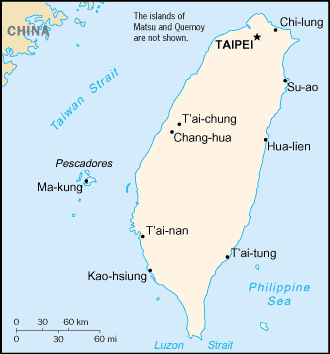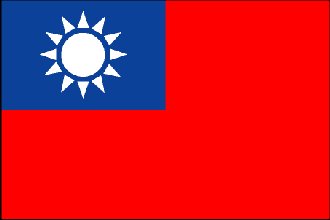
|
Taiwan
Background:
In 1895, military defeat forced China to cede Taiwan to Japan, however it
reverted to Chinese control after World War II. Following the communist victory
on the mainland in 1949, 2 million Nationalists fled to Taiwan and established
a government using the 1947 constitution drawn up for all of China. Over the
next five decades, the ruling authorities gradually democratized and
incorporated the native population within its governing structure. Throughout
this period, the island has prospered to become one of East Asia's economic
"Tigers." The dominant political issue continues to be the relationship between
Taiwan and China and the question of eventual reunification.
Location:
Eastern Asia, islands bordering the East China Sea, Philippine Sea, South China
Sea, and Taiwan Strait, north of the Philippines, off the southeastern coast of
China.
Area: Total: 35,980 sq km, land: 32,260 sq km, water: 3,720 sq km,
note: includes the Pescadores, Matsu, and Quemoy.
Area - comparative: Slightly smaller than Maryland and Delaware combined.
Coastline: 1,566.3 km .
Climate and Terrain:
Climate: Tropical; marine; rainy season during southwest monsoon (June to
August); cloudiness is persistent and extensive all year.
Terrain: Eastern two-thirds mostly rugged mountains; flat to gently rolling
plains in west.
Natural resources: Small deposits of coal, natural gas, limestone, marble, and
asbestos.
People:
Population: 22,370,461.
Ethnic groups: Taiwanese (including Hakka) 84%, mainland Chinese 14%, aborigine
2%.
Religions: mixture of Buddhist, Confucian, and Taoist 93%, Christian 4.5%,
other 2.5%.
Languages: Mandarin Chinese (official), Taiwanese (Min), Hakka dialects.
Government:
Government type: Multiparty democratic regime headed by popularly elected
president.
Capital: Taipei.
Economy overview:
Taiwan has a dynamic capitalist economy with gradually decreasing guidance of
investment and foreign trade by government authorities. In keeping with this
trend, some large government-owned banks and industrial firms are being
privatized. Real growth in GDP has averaged about 8% during the past three
decades. Exports have grown even faster and have provided the primary impetus
for industrialization. Inflation and unemployment are low; the trade surplus is
substantial; and foreign reserves are the world's fourth largest.
GDP - composition by sector: Agriculture: 3%, industry: 33%, services: 64%.
Statistics:
Telephones - main lines in use: 12.49 million.
Telephones - mobile cellular: 16 million.
Radio broadcast stations: AM 218, FM 333, shortwave 50.
Radios: 16 million.
Television broadcast stations: 29 (plus two repeaters).
Televisions: 8.8 million.
Internet users: 6.4 million.
Railways: Total: 4,600 km.
Highways: Total: 34,901 km, paved: 31,271 km, unpaved: 3,630 km.
Airports: with paved runways: 35, with unpaved runways: 4.
Heliports: 3.
Return to Visiting Locations
|

